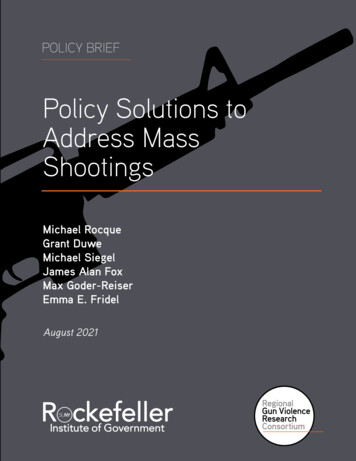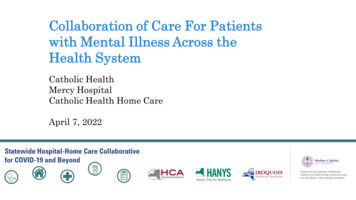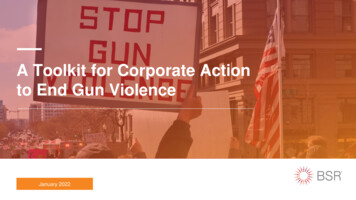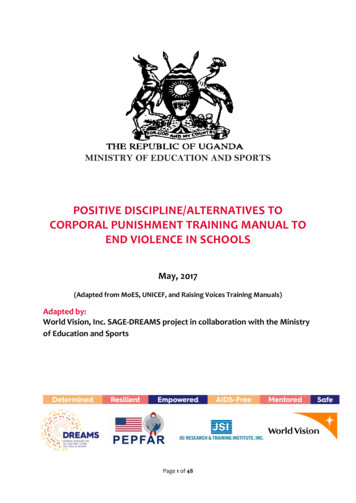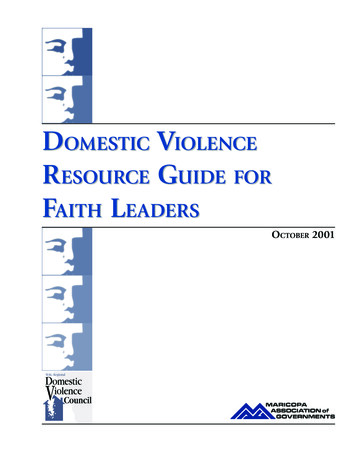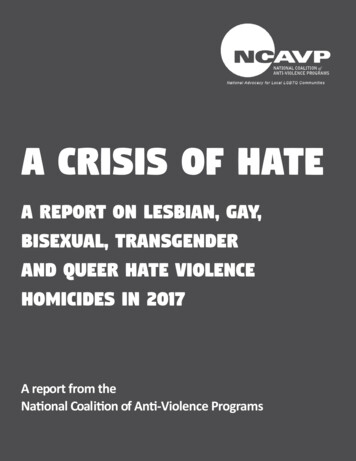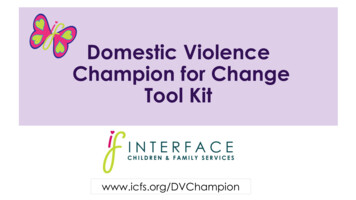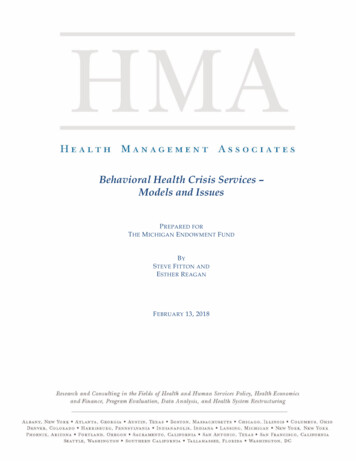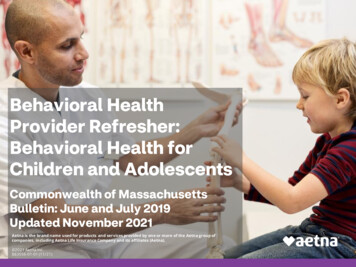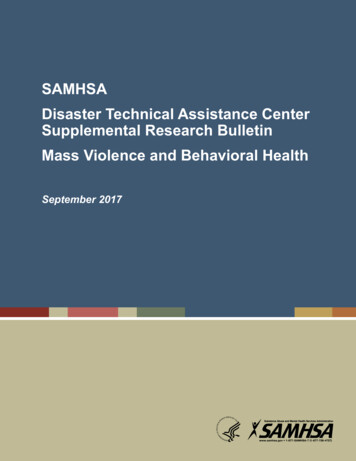
Transcription
SAMHSADisaster Technical Assistance CenterSupplemental Research BulletinMass Violence and Behavioral HealthSeptember 2017
CONTENTSINTRODUCTION3DEFINITIONS OF MASS VIOLENCE3Terrorist Attacks4Active Shooter Incidents4BEHAVIORAL AND MENTAL HEALTH REACTIONS TO MASS VIOLENCE4Immediate Behavioral Health Reactions5Long-term Behavioral Health Reactions6Reactions in Children8BEHAVIORAL HEALTH INTERVENTIONS FOLLOWING MASS VIOLENCEAdult Survivors88Screening for Trauma10Youth, Child, and Adolescent Survivors11MEDIA EXPOSURE AND MENTAL HEALTH FOLLOWING MASS VIOLENCE12INDIVIDUALS WITH PREEXISTING MENTAL HEALTH CONDITIONS AND MASS SA is not responsible for the information provided by any of the webpages, materials, or organizationsreferenced in this communication. Although the Supplemental Research Bulletin includes valuable informationand links, SAMHSA does not necessarily endorse any specific products or services provided by public or privateorganizations unless expressly stated. In addition, SAMHSA does not necessarily endorse the views expressedby such sites or organizations nor does SAMHSA warrant the validity of any information or its fitness for anyparticular purpose.
INTRODUCTIONThis issue of the Supplemental Research Bulletin focuses on how mass violence affects the behavioralhealth of adult and young (child and adolescent) survivors or witnesses of a mass violence incident. Wediscuss the phases of response experienced by survivors, as well as immediate and long-term reactionsamong adults and children and youth. This issue goes on to provide information on immediate and longterm interventions and the effects of mass media exposure following a mass violence incident. We brieflydiscuss the lack of research evidence in support of the idea that individuals with mental health issues aremore likely than others to be perpetrators of incidents of mass violence. We conclude the issue with anexamination of resilience.Public health, behavioral health, and emergency management professionals can use this issue toimprove their disaster behavioral health preparedness plans. We highlight several possible behavioralhealth inventions that may be helpful during the immediate and long-term phases of recovery from massviolence. Insights taken from this issue can also be used to help structure emergency planning exercises.In this issue, national as well as international resources were used to describe some of the findings,as mass violence is an issue around the world, and some regions (for example, the Middle East) haveexperienced it for longer periods of time and with greater frequency than the United States. However,this issue will focus mostly on the effects of mass violence resulting from terror attacks or active shooterincidents in the United States rather than state-perpetuated violence.Literature used in this issue includes scientific publications from the National Center for BiotechnologyInformation and U.S. National Library of Medicine (PubMed). Other sources were used to providedefinitions and reflect policy-level interventions, including various federal agencies (such as SAMHSA,the U.S. Department of Veterans Affairs, and the U.S. Department of Justice) as well as nonprofitorganizations (including the National Alliance on Mental Illness, the American Psychiatric Association, andthe American Red Cross) and international agencies (such as the World Health Organization).DEFINITIONS OF MASS VIOLENCEThe Office for Victims of Crime (OVC) and the American Red Cross define mass violence asan intentional violent criminal act, for which a formal investigation has been opened by the FederalBureau of Investigation (FBI) or other law enforcement agencies, that results in physical, emotional,or psychological injury to a sufficiently large number of people to significantly increase the burdenof victim assistance and compensation for the responding jurisdiction as determined by the OVCDirector. (U.S. Department of Justice [DOJ], Office of Justice Programs [OJP], OVC & American RedCross, 2005, p. 3).Additionally, the World Health Organization defines collective violence, the category closest to massviolence in one of its reports, as “the instrumental use of violence by people who identify themselves asmembers of a group—whether this group is transitory or . . . more permanent . . . against another groupor set of individuals, to achieve political, economic or social objectives” (Collective violence, 2002). In thisissue, we consider incidents of mass violence to include terrorist attacks. Page 3
Terrorist AttacksTerrorist attacks have increased in frequency in the last few decades, with the terrorists aiming eitherto create mass anxiety, fear, and panic and foster a sense of helplessness or to provoke reactions(Alexander & Klein, 2005; Horgan, 2017). According to LaFree (2017), terrorist attacks have increasedsteadily over the years—for example; in 2013 the total number of attacks was 135 percent of the total in1992. A fact sheet from the National Consortium for the Study of Terrorism and Responses to Terrorism(START) reports that, between September 11, 2001, and December 31, 2015, 3,140 Americans havebeen killed in terrorist attacks (Jensen & Miller, 2016).Fifty percent of the total number of people killed in terrorist attacks were killed in highly lethal terroristattacks, according to Martens, Sainudiin, Sibley, Schimel, and Webber (2014). They define highly lethalattacks as those in which 21 people or more were killed in a single incident. Data were gathered fromthe Global Terrorism Database (GTD) produced by START. The GTD includes broad categories of datafor terrorist incidents from 1970 through 2011 (but excluding 1993) (Martens, Sainudiin, Sibley, Schimel,& Webber, 2014). However, in spite of their large death toll, these attacks comprised only 3.5 percent ofall terrorist attacks (Martens et al., 2014). Terrorism is dynamic; the same terror group might, over time,change focus regarding the kind of recruit it favors, and accordingly change opportunities for involvementwhen the group is under pressure from authorities (Horgan, 2017).Active Shooter IncidentsThe FBI and Texas State University report that active shooter incidents increased in frequency annuallyin the period between 2000 and 2013. During this period, there were 160 active shooter incidents. Duringthe first 7 years, an average of 6.4 incidents occurred annually, while in the last 7 years that averageincreased to 16.4 incidents annually (Blair & Schweit, 2014).Shultz, Cohen, Muschert, and Flores de Apodaca examined firearms deaths in the United States from1990 to 2012 and included in their analysis active shooter incidents in schools (such as the SandyHook Elementary School shooting and the Virginia Tech shooting) (2013). They found that, while theseincidents get high levels of attention, they are rare occurrences, and the fatalities resulting from themequaled 0.12 percent of national firearm homicide for the same period; their rarity and extremity however,combined with identification with the affected population, tend to get media attention (2013). Followingthe Sandy Hook Elementary School shooting, a Twitter national dataset analysis showed association withsadness and anxiety (Dore, Ort, Braverman, & Ochsner, 2015). The same study showed that for peopleliving farther from the incident, or following a longer period, these reactions were shifted more towardsanxiety. The authors argue that remoteness (either through time or location) prompted higher-levelconsideration of the unresolved causes of tragedy (Dore et al., 2015).BEHAVIORAL AND MENTAL HEALTH REACTIONS TO MASS VIOLENCEFollowing incidents of mass violence, the survivors or witnesses may go through multiple phases in whichparticular emotions, behaviors, and other reactions are fairly typical (Alexander & Klein, 2005; Freedy& Simpson, 2007; Goldmann & Galea, 2014; U.S. Department of Health and Human Services [HHS],SAMHSA, Center for Mental Health Services [CMHS], 2004; Yehuda & Hyman, 2005). Page 4
1. Acute phase: Characterized by denial, shock, and disbelief. In this stage, behavioral health officialscan help survivors by providing them with resources and information. Mental health interventionssuch as Psychological First Aid, debriefing, accelerated resolution therapy, Skills for PsychologicalRecovery, and social support are most useful at this stage (Finnegan et al., 2016; Wade et al.,2014).2. Intermediate phase: Characterized by fear, anger, anxiety, transient panic, retaliatory attacks,difficulty paying attention at work or school, depressed feelings, and disturbed sleep.3. Long-term phase: Characterized by coming to terms with realities with alternate periods ofadjustment and relapse. This is the period when untreated behavioral health reactions might solidifyinto illnesses that would need specialized mental health or substance use disorder-related attention.Some of the survivors can incorporate these experiences into their lives and manage to increase theirsense of personal efficacy through their suffering. However, not all who were exposed to trauma cancome to terms with it, and these people find it difficult to reconstruct their lives (Goldmann & Galea, 2014;HHS, SAMHSA, CMHS, 2004; Yehuda & Hyman, 2005).Mass violence can result in a wide range of consequences including anxiety, depression, reduced senseof safety, stress or posttraumatic stress disorder (PTSD), sleep problems, feelings of guilt and shame,and increased risk of smoking and misuse of alcohol and other substances (Aakvaag, Thoresen, WentzelLarsen, Roysamb, & Dyb, 2014; Collective violence, 2002; DiMaggio, Galea, & Li, 2009; Palmieri,Chipman, Canetti, Johnson, & Hobfoll, 2010; Zemishlany, 2012). These reactions depend on three mainfactors: The directness and severity of the exposure: This factor relates to type of trauma exposure, whetherit is a threat to life, severe physical injury, receipt of intentional injury, exposure to grotesque scenes,loss of a loved one, or exposure of a loved one to violence (Goldmann & Galea, 2014). The presence of pre-disaster risk factors: Being part of a minority group, female, having lowereducational level, or having a history of mental or physical illnesses is associated with a higher riskof developing longer-lasting mental health problems after a disaster (Collective violence, 2002;Goldmann & Galea, 2014; HHS, SAMHSA, CMHS, 2004; Yehuda & Hyman, 2005). The post-disaster environment: This factor includes post-disaster life stressors (such as job loss,property damage, or personal loss) and level of social support (Goldmann & Galea, 2014; Nandi,Tracy, Beard, Vlahov, & Galea, 2009).Immediate Behavioral Health ReactionsImmediate reactions to an incident of mass violence or other traumatic experience may be in manydomains, including physical, behavioral, emotional, social, cognitive, and spiritual. Table 1 lists someexamples (National Child Traumatic Stress Network [NCTSN] & U.S. Department of Veterans Affairs[VA], National Center for PTSD, 2006; HHS, SAMHSA, CMHS, 2004; Yehuda & Hyman, 2005). Thesereactions usually vary among people based on their personalities, prior experience and attitude towardslife, and ability to integrate the experience into their lives.Immediate reactions usually are reported among a larger number of individuals than longer-termreactions. Common reactions include physical symptoms such as headaches, fatigue, gastrointestinal Page 5
upset, appetite changes, chest pain, rapid heart rate, or high blood pressure; cognitive changes anddysfunction; and increases in emotions such as fear or anxiety, anger or rage, and sadness (EasternMennonite University [EMU], Center for Justice & Peacebuilding [CJP], Strategies for Trauma Awarenessand Resilience [STAR], 2016). In keeping with these patterns of reactions, a study that followed Twitteraccounts of students after violent attacks on college campuses reported a significant increase in tweetswith negative emotions (Jones, Wojcik, Sweeting, & Silver, 2016).PTSD is not usually diagnosed in the early post-disaster phase, although people may experiencesymptoms—intrusive thoughts, flashbacks, avoidance of reminders of the traumatic incident, negativethoughts and feelings, and arousal and reactive symptoms—that if occurring months or years latercould lead to a PTSD diagnosis (American Psychiatric Association [APA], 2017). The APA writes thata diagnosis of PTSD requires the persistence of reactions for months and sometimes years, whereassimilar symptoms in the first month after a disaster are those of acute stress disorder (ASD) (2017).The National Center for PTSD cites studies estimating ASD prevalence after natural and human-causeddisasters at rates ranging from 7 to 33 percent (Gibson, 2016).Another possible short-term reaction is sleep problems. In a study investigating prevalence of sleepproblems in Israeli Jews after an actual or threatened terror attack or rocket attack, the prevalenceof sleep problems was 37 percent, and it was higher for people with probable PTSD (81 percent) orprobable depression (79 percent). Independent correlates for poor sleep in that study were beingfemale, older, less educated, and having experienced a major life stressor or psychological resource loss(Palmieri et al., 2010).TABLE 1: EXAMPLES OF BEHAVIORAL, EMOTIONAL, COGNITIVE, PHYSICAL, AND SPIRITUALIMMEDIATE REACTIONS FOLLOWING MASS VIOLENCE (EMU, CJP, STAR, 2007; Aakvaag et al., 2016;Alexander & Klein, 2005; DiMaggio et al., 2009; Freedy & Simpson, 2007; Goldmann & Galea, 2014; HHS, SAMHSA, CMHS, 2004;Palmieri et al., 2010; Seery, Silver, Holman, Ence, & Chu, 2008; Yehuda & Hyman, Sleep fusion anddisorientationChest painEmptiness/loss ofmeaningJumpinessAnxiety/fear/sadness/griefPoor concentrationand memory problemsAnger/rage or desirefor revengeRepeated flashbacksAvoidance of anyremindersIncreased substanceuse (alcohol anddrugs)Re-experiencingpain associated withprevious traumaHypervigilanceHigh blood pressureRapid heart rateGastrointestinalchangesDoubtFeeling unforgivenFeeling punishedShallow breathingLoss of directionDizziness or faintnessCynicism/apathyChills or sweatingAlienation/mistrust/crisis of faithFatigueSleep disturbancesHeadachesGrinding teethLong-term Behavioral Health ReactionsMost survivors do not develop disorders over the long term because of resilience, or “the ability tosuccessfully adapt to stressors, maintaining psychological well-being in the face of adversity” (Goldmann Page 6
& Galea, 2014; Haglund, Nestadt, Cooper, Southwick, & Charney, 2007, p. 889). This concept isimportant, as a sizable percentage of people (40–78 percent) exposed to mass violence events and otherpotentially traumatic events are either entirely or almost entirely free of symptoms of disorders over time(Zemishlany, 2012). According to multiple studies, only a minority of survivors will develop conditions thatreach diagnostic thresholds for PTSD, depression, and anxiety or have subclinical conditions months andyears after an incident of mass violence (HHS, SAMHSA, CMHS, 2004; Miron, Orcutt, & Kumpula, 2014;Nandi et al., 2009).Resilience is usually affected by a person’s ethnicity, gender, psychosocial support, and socioeconomicstatus, with the least resilient being lower income and having lower levels of education (Goldmann& Galea, 2014; Hobfoll et al., 2009). Lower household income, exposure to ongoing stressors, andexposure to traumatic events were found to be associated with depressive symptoms in a study followingthe 9/11 attacks (Nandi et al., 2009).Sometimes aspects of the disaster, particular disaster experiences, and individual differences seemto make it harder for survivors to activate resilience. Following the 9/11 terrorist attack in New York,the levels of PTSD and functional impairment declined after 4 years; however, there was a substantialincrease in suicidal ideation and missed days of work in the same follow-up period (Neria et al., 2013).Additionally, in a study conducted 10 to 11 years following the attack, a markedly large group of survivorswith mental health symptoms reported unmet mental health needs, especially those who lacked healthinsurance or social support (Ghuman, Brackbill, Stellman, Farfel, & Cone, 2014). The loss of someoneclose to the survivor was associated with a greater risk of mental illnesses including PTSD and majordepressive disorder, as well as suicidal ideation, functional impairment, and missing work (Ghumanet al., 2014). After the 2005 bombings in London, a need for treatment was reported for 47 percent ofparticipants who were screened for PTSD 2 years following the incident (Brewin et al., 2010). In schoolshootings, Miron et al. reported that people with greater emotional dysregulation and peritraumaticdissociative experience had quadruple the risk of developing posttraumatic stress symptoms 8 monthsafter the incident (2014).Following bioterrorism incidents (the anthrax attacks on Capitol Hill in 2001), among people with positivenasal swab tests, any post-incident psychiatric disorder was diagnosed (through structured interview) in54.6 percent, and PTSD in 27 percent (North et al., 2009). Of those who were physically exposed withouta positive nasal swab test, 24.4 percent were diagnosed with a post-incident psychiatric disorder; of thosewho were not physically exposed, 19.8 percent were diagnosed with a post-incident psychiatric disorder.Panic disorder was diagnosed in 1.5 percent, anxiety in 1.5 percent, and alcohol use disorder in 2.9percent of the interview participants (North et al., 2009).Other long-term implications of mass violence include substance misuse (Goldmann & Galea, 2014). In ameta-analysis studying substance use or misuse after mass trauma or terrorist incidents, the probabilitydistribution for increased alcohol use following a terrorist incident, based on synthesis of 17 studies, was20 percent that prevalence would be as high as 14 percent after 2 years. Cigarette smoking prevalenceincreased by 6.8 percent, and prevalence of mixed drug use was 16.3 percent (DiMaggio et al., 2009).Similar results were also reported in New York City public high school students following the 9/11 attacks(DiMaggio et al., 2009; Wu et al., 2006). In another study, a 1 percent increase in death because ofterrorism and mass violence was associated with an increase of 0.10–0.12 in alcohol and drug usedisability adjusted life years (Kerridge, Khan, Rehm, & Sapkota, 2014). Page 7
Reactions in ChildrenIn children, the experience of disasters, violent victimization, and sudden death of loved ones depends onstage of psychological development, gender, anxiety level, life and family situation, and critical caretakingrelationships (Kerns et al., 2014; La Greca et al., 2013; HHS, SAMHSA, CMHS, 2004; Pfefferbaum et al.,2014b; Pfefferbaum, Varma, Nitiema, & Newman, 2014). Human-caused violence may affect the child’strust in adults or in human nature. Children commonly implicate themselves in causing or worseningthe incident, which might result in feelings of shame and guilt as well as self-blame (Aakvaag et al.,2014; Gamwell et al., 2015; HHS, CMHS, SAMHSA, 2004). The higher vulnerability in children may beassociated with their lesser ability to deal or cope with their experiences (Goldmann & Galea, 2014;Norris, Friedman, & Watson, 2002).For adolescents, exposure to violent incidents may lead to fears, anxieties, and vulnerabilities thatare usually associated with a younger age. Six months following the Boston Marathon attack, youthfulmarathon attendants were found to have greater psychopathology, with PTSD being reported 6 timeshigher among marathon attendants than non-attendants (Comer et al., 2014). Additionally, following theUtoya shootings in Norway, students’ grades and functioning in school was found to be impaired afterexperiencing trauma, and there was a reported increase in days absent from school (Strom, Schultz,Wentzel-Larsen, & Dyb, 2016).BEHAVIORAL HEALTH INTERVENTIONS FOLLOWING MASS VIOLENCEMass violence affects large groups of individuals at the same time, whether they were survivors orwitnesses of the event where it occurred or followed it through media outlets. Interventions are appliedacross all phases of disaster, with pre-event services planned to enhance preparedness, and post-eventservices designed to enhance resilience and reduce signs and symptoms of distress and disorders, andpossibly to reduce long-term complications (Pfefferbaum et al., 2014b).Interventions to counter the effects of mass violence require the coordinated effort of the individualsexposed, first responders, medical and mental health institutions, family, friends, and society, as well aslocal and national organizations. Generally, interventions aim to promote a sense of safety and calming, asense of personal and community efficacy, connectedness, and hope (Hobfoll et al., 2007).Adult SurvivorsThe immediate (up to 1 year post-disaster) mental health interventions in adult trauma survivors are listedand briefly explained in Table 2. Page 8
TABLE 2: IMMEDIATE MENTAL HEALTH INTERVENTIONS FOR ADULT SURVIVORS OF INCIDENTSOF MASS VIOLENCEInterventionDescriptionPsychologicalFirst Aid“Psychological First Aid is an evidence-informed modular approach to help children,adolescents, adults, and families in the immediate aftermath of disaster and terrorism. [It] isdesigned to reduce the initial distress caused by traumatic events and to foster short- andlong-term adaptive functioning and coping” (NCTSN & VA, National Center for PTSD, 2006;Fetter, 2005; Goldmann & Galea, 2014). Principles and techniques of Psychological First Aidare consistent with research, applicable in the field, appropriate for people at all developmentallevels over the life course, and designed to be customizable to work well with a variety ofcultures.Rapid assessment determines those survivors in most acute distress and in need of medicalattention. This can also be performed in trauma centers for injured survivors (Petrie & Zatzick,2010).CommunityoutreachCommunity outreach could include initiating supportive and helpful contact sites; reaching outto survivors through the media, the Internet, and 24-hour telephone helplines; participatingin or conducting meetings for preexisting groups as well as providing psycho-educationalresources and referral information. Monitoring the well-being of the entire community or areathat was harmed and/or threatened by the attack is critical, and integrating mental healthinterventions into existing community services makes them more acceptable to the population(Goldmann & Galea, 2014; Grills-Taquechel, Littleton, & Axsom, 2011; Hobfoll et al., 2011;Sherrieb & Norris, 2013).PsychologicaldebriefingDebriefings are a type of intervention that can be used following a disaster or other traumaticevent. The technique is applied within 48 hours of the traumatic event. In debriefing, victimsare asked to describe the event and their emotional responses to it in detail. The method wassuggested to reduce stress; however, there are some questions on the effectiveness ofpsychological debriefing, as it may strengthen the memories of the traumatic event,impair the natural recovery process, and even worsen the symptoms (VA, NationalCenter for PTSD, 2016; Fetter, 2005; Goldmann & Galea, 2014; Sijbrandij, Olff, Reitsma,Carlier, & Gersons, 2006). Critical Incident Stress Debriefing (CISD), a psycho-educational small group process,was developed exclusively for small, homogeneous groups who have encountered apowerful traumatic event. CISD aims to reduce stress and restore group cohesion andunit performance (Mitchell).PsychoeducationPsycho-education is an important component of behavioral health interventions followingimmediate traumatic impact. In psycho-education, information is provided about post-traumareactions, grief and bereavement, effective coping strategies, and when to seek professionalconsultation. Brochures or simple handouts are usually widely distributed in appropriatelanguages (HHS, SAMHSA, CMHS, 2004; Petrie & Zatzick, 2010).Mental healthconsultationMental health professionals can be brought into decision-making and planning teams to adviseleaders regarding mental health issues such as optimal scheduling, mental health support, andleave time for rescue and recovery workers, as well as other possibly sensitive procedures oractivities (for instance, identifying body parts) (HHS, SAMHSA, CMHS, 2004; DOJ, OJP, OVC& American Red Cross, 2005). Page 9
Activities for long-term mental health intervention include the following: Screening to identify individuals and groups in need of mental health and crime victim assistanceservices and to prioritize the delivery of more intensive mental health services (Brewin et al., 2010;Hobfoll et al., 2011; Johnson-Agbakwu, Allen, Nizigiyimana, Ramirez, & Hollifield, 2014). Providing a range of crime victim services. Crime victims, their families, and others affected by thecrime may receive crisis intervention and counseling, advocacy, grief and trauma counseling, andinformation and referral (DOJ, OJP, OVC & American Red Cross, 2005). Providing mental health support and consultation for community events (Birkeland, Nielsen,Knardahl, & Heir, 2015; Grills-Taquechel et al., 2011; Pfefferbaum et al., 2014b). Providing appropriate psycho-educational information to all affected survivor and responder groupsand health care and social service providers in the community (Alexander & Klein, 2005; HHS,SAMHSA, CMHS, 2004; DOJ, OJP, OVC & American Red Cross, 2005).Screening for TraumaScreening for trauma is a very important step to help identify the affected people, gauge the severityof their condition, and determine whether they require referral to specialized institutions for treatmentor further evaluation (Goldmann & Galea, 2014). Screening can be done through phone interviews toestimate the prevalence of PTSD and depressive symptoms. In a study conducted in Jerusalem using asample of Jewish and Arab residents during a period of heightened threats, phone interviews to screen forbehavioral health impact proved as effective as in-depth personal interviews in identifying the prevalenceof these symptoms (Hobfoll et al., 2011). The researchers note that this method would prove very usefulin reaching out to a higher percentage of the population, for epidemiological and census purposes as wellas to guide public health intervention resource allocation (Hobfoll et al., 2011). It can also provide usefulmeans in reaching out to displaced people (Goldmann & Galea, 2014). In a study evaluating the mentalhealth of refugees, publicly listed telephone numbers with surnames known or thought to be related weresearched, and a random sample was contacted and interviewed (Wagner et al., 2013). This can also beimplemented using available lists to identify individuals who are known to have lived in the disaster areaprior its occurrence to create a contact list to screen for post-disaster mental health impacts.Mental health providers should keep in mind that not all people who were exposed to the potentiallytraumatic experience of an incident of mass violence will seek help. In a study, potential unmet mentalhealth needs were reported in New York 6 months after the 9/11 terrorist attacks (Stuber, Galea,Boscarino, & Schlesinger, 2006). In that study, more than 60 percent of respondents with probable PTSDor depression did not seek help despite diminished functioning. Some barriers to help-seeking reportedby the investigators were concerns about negative, inaccurate perceptions about mental health servicesand those who access them, along with the feeling that other people needed the help more than they did.On the other hand, people with physical health problems or who already were connected to mental healthservices had a higher probability of seeking mental health help (Stuber et al., 2006). Page 10
Further in the recovery process, CMHS and others identify the following tasks for mental health services(2004):1. Identify those in need of medical mental health attention for stress reactions (for example, those inneed of cognitive behavioral therapy or medications) (Goldmann & Galea, 2014).2. Provide supportive assistance.3. Facilitate connection of survivors with family and friends who can provide social support and easepain and suffering (Grills-Taquechel et al., 2011).4. Provide information about the status of the crime scene, perpetrator(s), and immediate lawenforcement efforts (DOJ, OJP, OVC & American Red Cross, 2005).Youth, Child, and Adolescent SurvivorsFor young disaster survivors, interventions should work to protect and enhance existing social supportand foster resilience (Pfefferbaum et al., 2014b). The choice of an intervention must be matched to thechild’s reactions and the course of symptom development and recovery following disaster exposure. Inchildren, the course of disaster usually follows the same trajectory as in adults, leading either to resilienceand recovery or development of chronic behavioral health issues (Pfefferbaum et al., 2014a). In idealsituations, the child’s close social circle or environment would be able to help mitigate the effect ofdisaster and initiate recovery.The first level of intervention in children is the immediate social group including parents, siblings, andclose friends who can help children cope with the situation by assisting with emotional processing, servingas familiar faces, and providing a distraction from the incident (2014a). Siblings and friends can providesocial support and help maintain or regain everyday routine.The second level of intervention according to Pfefferbaum et al. is through linking mental health serviceswith schools, parents, e
The directness and severity of the exposure: This factor relates to type of trauma exposure, whether it is a threat to life, severe physical injury, receipt of intentional injury, exposure to grotesque scenes, loss of a loved one, or exposure of a loved one to violence (Goldmann & Galea, 2014).
